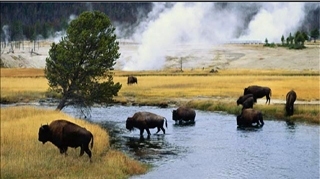|
St. Luke’s Episcopal Church – 125 Anniversary
Source: The church's Centennial book by Nancy Westerfield
Parts by John Haberly, Nancy, Hal Colony
Founded
by English settlers – grew up in Episcopalian church
Oct. 22, 1882 – Group - Rev. George Green and 6 others met and drew up a
letter of application to establish an Episcopalian church in Kearney.
They said they would be serving a
population of 3,000 but 10 would attend.
They would have a budget of $200.
First called the church of the Good
Shepherd.
Buildings
–
First met in a small building on the site
of the present building. It burned.
Replaced by a larger building to the north.
1908 - the present brick structure was erected on the south side of the
second building.
Puts on the site of the first
building.
Means the Episcopalians have been at
one site longer than any other church in Kearney.
All the main churches used to be grouped in the area from 2nd to D, 20th
to 25th.
1923 – Built the Chapel of the Good Shepherd on north side of building.
Fellowship hall to north
First Rector
- 1884 – Dr. Robert Oliver called to be rector.
He had connections with families in
the East who made contributions to help the church.
When he first arrived he said the
church building was “much smaller than the mortgage on it.”
Name change
- 1888 – Dr. Oliver had raised enough money to pay off the debt and the
church could be consecrated. Feb. 28, 1888.
Name changed to St. Luke’s
1890
– The Nebraska diocese was divided in half.
Kearney, in the western diocese, wanted
the bishop to live here so they
Bought a big house on 14th St & 8th
Ave.
The bishop, Anson Graves, also had
the offer of a house in North Platte
Chose Kearney because the house was
in better repair and ready for his family to move in.
Summer 1890 – Kearney offered land in northeast Kearney to be used for a
school,
Grave’s went east and raised the
money.
1892
– Platte Valley Collegiate Institute opened. A school for both girls
and boys.
1898
– Spanish-American War – school changed to a military academy for boys.
1900
– Budget $1,022 Income
Expenses included $483.16 for the
rector
$ 1.50 for communion wine
1901 – three unpaid bills at end of
year included $1.50 for communion wine
First Rector
- Dr. Robert Oliver.
Born in Scotland.
Trained to be an officer in the Army.
At age 23 assigned a diplomatic mission to the US.
Spent some leave time in the West Indies
where he met a group of people who convinced him to resign from there
army and take up the ministry. Which he did.
Served in Pittsburg & Philadelphia. Ordained in priest of Episcopal Church
in 1855.
Civil War – Declined Lincoln’s offer of a commission but agreed to be a
chaplain.
After the war, served in several positions in Kansas and Nebraska
1884 - Bishop asked him to visit the mission in Kearney.
Determined they needed a missionary
to lead them.
Finding none, he decided to do it
himself.
Got a new roof on the building,
installed stained glass windows.
1890 health failed.
1895 - Given a leave of absence - the congregation would not accept his
resignation.
1896 - The following year when he returned they hired an assistant.
1899 - died in Philadelphia but was brought back here to be buried by his
wife who had died 6 years previously.
Some men in the founding group
J. J. Bartlett – With R. L. Downing formed the Kearney Flour Mill &
Elevator Co.
Pres. of Midway Brickyard, 3407 Ave.
B – east side of Hibbard’s. Successor to Mannix Brickyard of that address
that disappeared from the city directory when this one appeared; also one of
officers and became sole operator later.
Lived at 1402 9th Ave. – now one of
the show places in Kenwood, restored
He brought many furnishings from
England
One of group of early Kearney
citizens who promoted the construction of the Kearney Canal.
Kearney Canal
formally opened July 4, 1886.
First boat
ride on the canal went to Frank, J. T. O’Brien & J. J. Bartlett.
“Their promotional and organizational
skills surpassed their boatsmanship because the boat capsized and
the crew were all treated to a good ducking.” Alice Howell wrote in
BT story “Kearney 100 years ago”
W. C. Tillson – Banker. House used as Kearney country club until the
present one was built.
Henry Wiley – Came from Vermont.
Along with Bartlett, officers in the
West Kearney Improvement Co. and Kearney Land and Investment Co.
Manager of the latter.
Had an office in the Midway Hotel
when it burned.
The tree south of the church
About 1900 – Vestry minutes
Issue was
removal of tree south of the church
Voted again &
again before it was finally passed
Seems silly –
but we had no trees at first and each one was valuable
|

